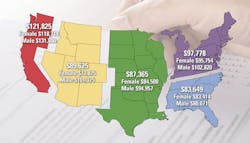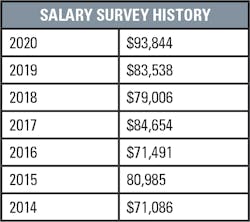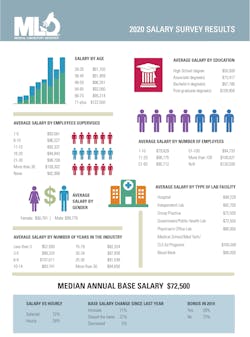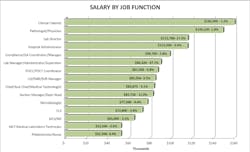MLO’s 2020 Annual Salary Survey of laboratory professionals
Medical Laboratory Observer’s 2020 annual salary survey of laboratory professionals revealed a sizable jump in the average salary, based on the responses of all participants, although quite a few job categories recorded drops in pay.
In MLO’s 2020 salary survey, the average compensation across all positions was $93,844, up from $83,538 in 2019. For females, the average was $90,761, up from $79,413 in the 2019 survey, and $99,779 for men, up from $97,328 in the 2019 survey.
To some degree, employment and compensation trends at clinical laboratories reflect robust demand for these professionals. As the U.S. population ages, fueling demand for lab tests, the number of positions available in clinical labs is predicted to grow quickly. The Bureau of Labor Statistics expects employment for clinical lab technologists and technicians to grow 11 percent, adding 35,100 positions, from 2018 to 2028.1 The bureau expects the number of positions for phlebotomists to grow even faster, by 23 percent, during the same time period, adding 29,500 positions.2
Demographics
In addition to demand for employees, the substantial increase in compensation overall and among females could be explained, in part, by the demographics of participants in the 2020 and 2019 surveys.
For example, more survey respondents in 2020 were in management positions than was the case in 2019. In the 2020 survey, 77 percent of respondents were lab directors, managers, administrators, section managers or department heads, compared with 58 percent in 2019.
The proportion of managers involved in the 2020 survey versus the 2019 survey also was reflected in the breakdown of salaried and hourly employees. Nearly three-quarters were salaried employees, or 72 percent, in the 2020 survey, compared to 57 percent in 2019.
And in both 2020 and 2019, the majority of survey respondents—68 percent in 2020 and 76 percent in 2019—were females.
In the 2020 survey, nearly all survey respondents (93 percent) work at hospital labs, compared with three-quarters (76 percent) in 2019. The largest percentage of them (42 percent) were between 56 and 65 years of age, while another 26 percent were between 46 and 55 years of age.
Compensation trends
Overall, salaries increased for some positions in the lab in the 2020 survey. Salaries rose $3,522 to $90,329 for lab managers and administrators, $2,750 to $149,100 for pathologists, and $8,083 to $77,500 for microbiologists.
The average salary for compliance and quality assurance coordinators and managers soared by $16,109 to $98,700. However, only 10 people responded to that question on the survey in 2020, compared with 22 people in 2019.
Other salaries dropped. For example, salaries decreased by:
- $2,622 to $115,789 for lab directors
- $1,037 to $82,758 for section managers and department heads
- $2,060 to $52,500 for medical technologists
- $3,610 to $65,000 for medical laboratory scientists
- $2,111 to $85,056 for LIS/EHR/EMR managers
When asked what their annual base salary was expected to be in 2020, the median among survey respondents was $72,500. Fifty percent said they expect a pay increase of between 2 and 4 percent, and 22 percent said they expect a pay bump of less than 2 percent. When asked about their salary in 2019, 71 percent reported an increase and 27 percent reported a decrease.
Bonuses and benefits
In terms of bonuses and benefits, the results of the 2020 survey were similar to the 2019 survey.
The percentage of survey respondents (72 percent) who said they did not receive a bonus in 2019 was nearly identical to the percentage of respondents (71 percent) who said they did not receive a bonus in 2018.
Nearly all respondents in the 2020 survey said their employers offer health insurance, dental insurance and a 401K plan or pension.
Other benefits showed modest growth in prevalence between the 2019 and 2020 surveys including:
- 91 percent with vision insurance in 2020, up from 87 percent in 2019
- 88 percent with life insurance in 2020, up from 86 percent in 2019
- 85 percent with paid time off in 2020, up from 81 percent in 2019
- 78 percent with disability insurance in 2020, up from 77 percent in 2019
- 13 percent with flex time in 2020, up from 12 percent in 2019.
Some benefits saw declines between 2019 and 2020 such as paid holidays (67 percent versus 58 percent), overtime pay (43 percent versus 33 percent) and childcare (6 percent versus 5 percent).
Regional salary breakdown
As has been the case for numerous years, the Pacific region reported the highest average salary in the 2020 survey: $121,825 ($118, 714 for females and $131,800 for males).
For the other regions, salaries were as follows:
- $97,778 in the Northeast ($95,754 for females and $102,820 for males)
- $89,625 in the Mountain States ($77,875 for females and $101,375 for males)
- $87,365 in the Central region ($84,500 for females and 94,957 for males)
- $83,649 in the Southeast ($83,414 for females and $80,071 for males)
Compensation and organization size
Employees at larger organizations—measured by either number of employees or volume of tests—often earned more than their counterparts at smaller organizations.
Among the largest labs, or those with more than 100 employees, the average salary was $106,627, compared with $94,733 for facilities with 51 to 100 employees, $90,712 for facilities with 21-50 employees, $86, 175 for facilities with 11-20 employees and $79,629 for facilities with 1-10 employees.
Labs with largest test volume—more than 2 million tests—had the largest average salary at $113,308. The average salary declined as the volume of tests declined, except for the smallest category (fewer than 25,000 tests), where the average salary was $96,478. In other categories, the average salary ranged from $98,250 for labs with 1-2 million tests to $75,250 for labs with between 25,001 and 50,000 tests.
Satisfaction and security with current position
Overall, laboratorians are secure and satisfied with their work.
When asked how secure they are in their current position, 50 percent of respondents said they were “very secure” and 43 percent said they were “somewhat secure,” while 5 percent said they were “somewhat insecure” and less than 1 percent said they were “very insecure.”
In a similar vein, 47 percent said they were “very satisfied” with their job and 39 percent said they were “somewhat satisfied,” while 11 percent said they were “somewhat dissatisfied” and 2 percent said they were “very dissatisfied.”
Education and training
Laboratorians take education and training seriously.
When asked about their highest level of education, 35 percent said they have post-graduate degrees, 55 percent have bachelor’s degrees and 9 percent have associate degrees. Less than 1 percent said a high school diploma was their top education credential.
In two of three higher-education categories, females earn less than their male counterparts. The average salary was $109,959 ($105,087 for females and $117,016 for males) for those with post-graduate degrees, $87,785 ($87,757 for females and $85,357 for males) for those with undergraduate degrees, and $73,417 for associate degrees ($70,950 for females and $85,000 for males).
The most common professional certification was from the American Society for Clinical Pathology, which was held by 76 percent of survey participants. The other common certifications were from state governments (13 percent of respondents) and the National Credentialing Agency for Laboratory Personnel (9 percent of respondents).
Laboratorians also reported many hours of continuing education in the 2020 survey. Fifteen percent earned more than 20 hours and nearly 29 percent earned between 11-20 hours.
Tenure
Clinical labs include employees with long tenure as well as relative newcomers. In 2020, the number of years survey respondents have been working at their current employer was as follows:
- 11 percent for less than 3 years
- 12 percent for 3-5 years
- 11 percent for 6-9 years
- 12 percent for 10-14 years
- 9 percent for 15-19 years
- 14 percent for 20-24 years
- 10 percent for 25-30 years
- 21 percent for more than 30 years
Lab operations and management
As has been the case in previous years, the MLO salary survey also included questions about laboratory operations.
The ongoing shortages of qualified personnel continues to impact laboratory operations, with 26 percent of respondents describing it as a “large” impact and 47 percent describing it as a “moderate” impact. A minority (22 percent) said the shortages had a “low” impact.
Despite the challenges involved in hiring enough people, 82 percent said they have not outsourced more lab tests, compared with 85 percent in the 2019 survey.
To build test volumes, many labs are focused on outreach efforts to other organizations. Among MLO’s survey participants, the focus of outreach efforts included:
- Physician’s practices (55 percent)
- Nursing homes (37 percent)
- Community members (30 percent)
- Other laboratories (18 percent)
- Home care (15 percent)
In addition, 29 percent of survey participants said they had minimal or no outreach efforts at their organization.
In other management trends, labs continue to embrace molecular diagnostics in microbiology and adopt automated solutions.
Adoption of molecular diagnostics in microbiology was on an upward trend—from 67 percent in 2019 to 73 percent in 2020.
However, the percentage of survey participants who have adopted molecular diagnostics in other sections of the lab showed very little change from 2019 to 2020:
- from 12 percent to 11 percent in chemistry
- from 8 percent 7 percent in hematology
- from 4 percent for both years in blood bank operations.
The percentage of labs that automated new procedures was 42 percent, down from 49 percent in the 2019 survey.
Conclusion
The MLO Salary Survey depicts a laboratory workforce that is highly educated, embraces ongoing training to further hone their skills, and feels secure and satisfied in their jobs. But as is the case in many fields, laboratorians are confronted with a persistent gender pay gap.
References
- BLS.gov. (2019). Medical and Clinical Laboratory Technologists and Technicians: Occupational Outlook Handbook: U.S. Bureau of Labor Statistics [online] Available at: https://www.bls.gov/ooh/healthcare/clinical-laboratory-technologists-and-technicians.htm [Accessed 30 March 2020].
- BLS.gov. (2019). Phlebotomists: Occupational Outlook Handbook: U.S. Bureau of Labor Statistics [online] Available at: https://www.bls.gov/ooh/healthcare/phlebotomists.htm [Accessed 30 March 2020].




